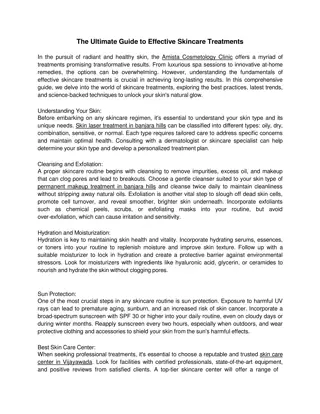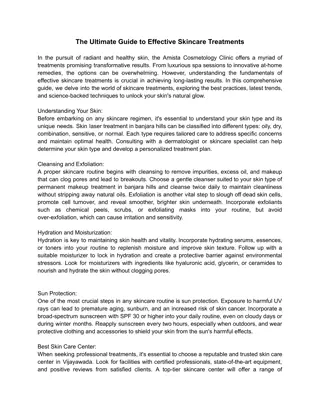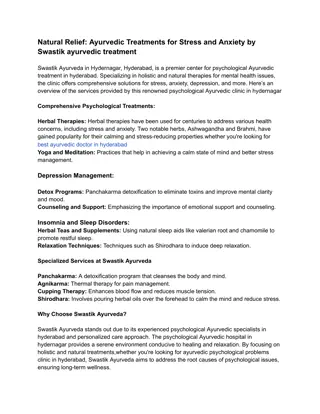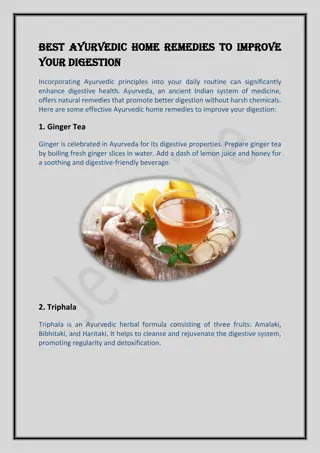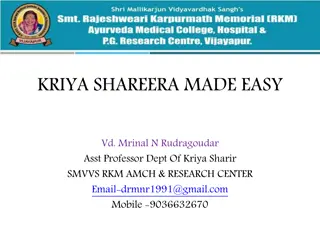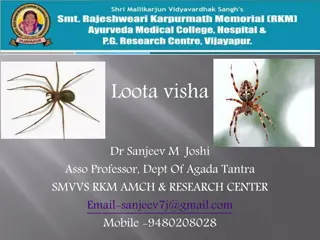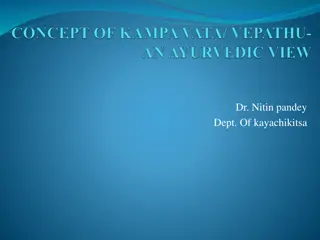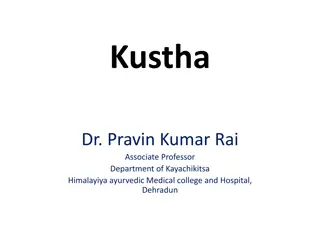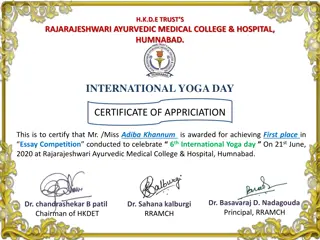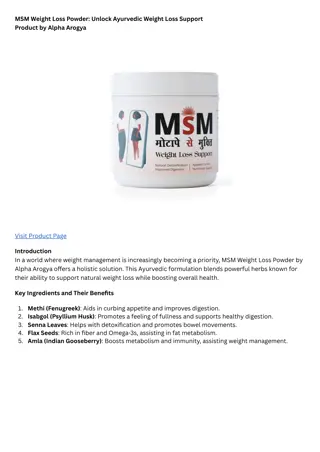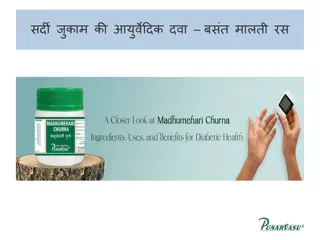Ayurvedic Treatments for Dosha Imbalance: Vata, Pitta, Kapha
Ayurveda offers specific treatments for imbalances in Vata, Pitta, and Kapha doshas, focusing on unique therapies, dietary adjustments, and lifestyle recommendations to restore balance and promote overall well-being.
Download Presentation

Please find below an Image/Link to download the presentation.
The content on the website is provided AS IS for your information and personal use only. It may not be sold, licensed, or shared on other websites without obtaining consent from the author. Download presentation by click this link. If you encounter any issues during the download, it is possible that the publisher has removed the file from their server.
E N D
Presentation Transcript
DOSHOPAKRAMANEEYAM - TREATMENT OF DOSHAS
TREATMENT FOR INCREASED VATA DOSHA 1. massage 2. / sveda sudation diaphoresis, sweating therapy 3. / mrudusamshodhana mild purification procedure, mild panchakarma (vamanaand virechana). / sneha oleation-oral administration of oil / ghee / fat and external oil 4. /svaduamla lavanaushna bhojya foods which are of sweet, sour and salt taste; 5. / abhyanga oil massage 6. / mardana simple massage 7. / veshtana wrapping / covering the body/ organ with cloth excess of panchakarma might lead to vata increase.
TREATMENT FOR INCREASED VATA DOSHA 8. / trasana threatening, frightening 9. / seka pouring of herbal decoctions / oils on the affected part 10. / paishtikagoudika madya wine prepared from corn flour and jaggery- molasses 11. /snigdha ushna basti enema therapy with fat-oil, enema with drugs of hot potency 12. / sukhasheelata comforting the patient / deepanapachana siddhasneha medicated fats of different kinds- sources prepared with drugs causing increase of hunger and improving digestion; / medyapishita taila anuvasana oleationenema prepared from juice of fatty meat and oil- 13. 14.
TREATMENT FOR PITTA IMBALANCE (INCREASE)
TREATMENT FOR PITTA IMBALANCE (INCREASE) / sarpi paana drinking of ghrita (clarified butter). it can be plain or medicated, based on physician s advice. 1. 2. / svadu, sheetavirechana purgation therapy with drugs of sweet taste and cold potency, 3. / intake of foods and drugs having sweet, bitter and astringent tastes. 4. / inhaling of fumes from herbs that are coolant, pleasant and cordial 5. / anointing the body with / camphor, sandalwood paste / vetiverpaste, very frequently.
TREATMENT FOR PITTA IMBALANCE (INCREASE) 6. residing on terraces lit by moonlight in the evenings, 7. enjoying pleasant music and 8. / soft cold breeze, 9. / company of friends who do not restrain him, / of sons who speak cordially and with innocence. 10. 11. / spending time with wife, who is obedient, pleasing and virtuous; residing in houses 12. equipped with fountains emitting cooled water, parks and ponds, spending time in houses near water reservoirs having 13. clean water, sand, lotus, flowers, and trees, with a calm mind; consuming milk, ghee and purgation therapy (virechana) 14.
TREATMENT FOR KAPHA IMBALANCE (INCREASE)
TREATMENT FOR KAPHA IMBALANCE (INCREASE) 1. vamanavirechana strong emesis and purgation in accordance with prescribed procedure, 2. consuming food which are dry, 3. consuming food in limited quantity 4. - consuming food that have teekshna (strong, piercive), ushna (hot), pungent, bitter and astringent taste, 5. old wine 6. sexual activity 7. - keeping awake at night, 8. exercises of different kinds, -vidhiyukta teekshna
TREATMENT FOR KAPHA IMBALANCE (INCREASE) 9. 10. dry massage of the body; 11. vamana emesis therapy, drinking of soups- of grains use of honey, therapies and medicines that reduce fat - inhalation of medicinal smoke, worry, 12. 13. 14. 15. 16. fasting,
TREATMENT FOR KAPHA IMBALANCE (INCREASE) 17. - gargling - facing difficulties 18.
TREATMENT FOR KAPHA IMBALANCE (INCREASE) The different treatment prescribed for each dosha individually, may be combined appropriately in conditions of combinations of two or three doshas.
, 1. the regimen of summer-grishma described in chapter 3. generally the treatment for the combination of vata and pitta is similar to 2. for kapha and vata combination treatment, it is similar to the regimen of vasanta- spring a. because maruta- vata is yogavahi; b. yogavahi means, vata, when associated with pitta, boosts augments pitta dosha, when it is associated with kapha, it boosts kapha dosha. 3. For the combination of kapha and pitta the treatment shall be similar to the regimen of sarad- autumn
1. chaya - the doshas should be treated properly when they are in chaya stage (mild increase) only. 2. kopa - in their stage of kopa (dosha enhanced imbalance), a. They should be vanquished without opposing / interfering with one another dosha. 3. prakopa - when there is simultaneous enhanced increase (kopa) of all the three doshas, a. The most powerful / most aggravated dosha should controlled first, without opposing the remaining doshas.
SUDDHA-ASUDDHA CIKITSA to another disease- sooner or later, is not shuddha- pure/ good/appropriate; that treatment which cures one disease and gives rise a pure treatment is that which cures one diseases and does not give rise to another.
MOVEMENT OF DOSHAS Movement from koshta to shakha by the effect of 1. exercise, 2. increase of heat, 3. - unsuitable/unhealthy activities and 4. due to quick movement of vata The increased doshas move out of the kostha (gastrointestinal tract) to the a. shakhas- tissues, b. asthi bones and c. marmas- vital organs d. and vulnerable points.
MOVEMENT FROM SHAKHA TO KOSHTA Doshas move from body channels and tissues to the gastro intestinal tract, by the effect of a. purification, b. clearing and widening of the minute body channels. c. by further increase of doshas, d. by liquefaction, e. by maturity, f. by balancing and controlling vata. When doshas move from one place to other, they remain there for some time, waiting for an exciting / powerful cause / factor. after deriving strength by season, time etc, they get further aggravated and move to other places as well
STHANI AND AGANTU DOSHAS NATIVE AND FOREIGN DOSHAS Treatment should be done- especially on priority to that dosha which has travelled into the seats of other doshas and which is weak, Priority should also be given to that dosha which, by its own strength overcomes other doshas.
AGANTU DOSHA foreign dosha, should be treated a. either after treating the sthanika (native dosha) b. or even otherwise. the choice of dosha, to be treated first depends on the level of aggravation and strength of doshas.
TIRYAK GATA DOSHA Usually, the tiryaggata doshas which are not localized in the gastrointestinal tract but localized in the tissues, cause troubles to the patient for a long time; They should not be treated in haste. 1. They should be carefully treated only after determining the strength of the body and digestive activity. 2. They should be mitigated with stipulated palliative treatment 3. Or they should be brought into the alimentary tract and then they should be expelled out by the nearby route (either by mouth by emeisis vamana or by anal route, by purgation virechana)
EFFECTS OF DOSHAS ASSOCIATED WITH AMA -SAMADOSHA LAKSHANA , false metabolism), it is called as saama dosha. When imbalanced doshas get associated with ama (a factor of indigestion / The symptoms of malas associated with or mixed with ama 1. srotorodha - obstruction of the channels, pores 2. balabhramsha loss of strength, 3. gaurava feeling of heaviness of the body, 4. anila moodata inactivity of anila-vata,
EFFECTS OF DOSHAS ASSOCIATED WITH AMA -SAMADOSHA LAKSHANA 5. 6. apakti loss of digestive power, 7. nishteeva person spits saliva frequently, more of expectoration, 8. malasanga constipation or low frequency of urination leading to accumulation of wastes 9. aruchi anorexia, 10. klama exhaustion alasya laziness, lassitude,
PRODUCTION OF AMA rich part is called as rasa dhatu. Soon after digestion process, the useful part gets separated from the waste. the useful, nutrition Due to lack of digestion strength, the first dhatu , rasa dhatu does not form well / remain uncooked / not digested, it remains in raw, weak form. it gets vitiated, It stays in the amashaya (stomach and small intestines) itself, And is known as ama increased doshas Just as poison gets formed from mixing of different kinds of kodrava Other authors opine that ama gets formed from intimate mixing with one another of greatly
which get mixed with this ama are designated as sama mixed with ama; The diseases originating from this saama dosha are called as saama vyadhi The doshas and dusyas (the dhatus and malas)
saama dosha chikitsatreatment of sama doshas The sama doshas 1. which are spread all over the body, 2. which are lurking in the dhatus and 3. which are not moving out of their places of accumulation, Should not be forced out by purification panchakarma therapies like emesis, purgations etc. just as attempts of extracting juice from an unripe fruit leads to destruction, of the dwelling place itself , so also it will be very difficult to to expel them out along with ama right approach in sama dosha treatment
sama doshas should be treated 1. First with drugs which are digestive and which increase hunger; 2. Next with oleation-snehana sudation therapies, -svedana 3. Finally they should be expelled out with shodhana therapies- emesis, purgation At the proper time, and in accordance with the strength of the patient. -
1. Drugs administered through the mouth, bring out the malas / doshas from the amasaya- stomach and small intestines; 2. Drugs administered through the nose bring out the doshas from the parts above the shoulders and 3. drugs administered through the rectum bring out the doshas from the pakvasaya large intestine.
saama doshas which are greatly increased and going out of the body on their own accord, 1. either in the upward or downward routes- vomiting and purging respectively 2. should not be stopped by medicines, 3. for they produce diseases, if they are stopped
TIME FOR ELIMINATING DOSHA OUT OF THE BODY 1. vata which undergoes mild increase (chaya) in greeshma (summer) should be removed from the body (by basti- enema) in shravana masa (august) 2. Pitta which undergoes mild increase in varsha (rainy season), should be expelled out of the body in kartika month (by virechana purgation) 3. kapha which undergoes mild increase in shishira (winter) should be expelled out in chaitra month (april) by vamana.
greeshma, varsa and hemanta [summer, rainy season and winter]- have too much of heat, rain and cold respectively; in the period in between these, known as sadharana kala; the doshas should be cleared out.
after having overcome the effects of cold, hot and rainy seasons suitably- by adopting appropriate protective methods necessary treatment therapies should be administered; The kriyakala- period of abnormal activity, stages of disease evolution should not be allowed to progress- further.
AUSHADHA SEVANA KALA TIME OF ADMINISTRATION OF MEDICINES Medicines should be administered, 1. ananna on empty / when there is no food- in the stomach ; 2. annadau just before food or at the beginning of food intake, 3. anna madhye during / in between food intake 4. anna ante at the end of food intake. 5. kavalantare in between morsels 6. grase grase with each morsel 7. muhu: repeatedly, many a times a day 8. sa annam mixed with food 9. samudgam before and after food 10 nishi at night, bed time
, , 1. ananna for diseases arising from increase of kapha, which are severe and for persons who are strong, the time of administration of medicine shall be when there is no food- in the stomach ; 2. annadau in disorders of apanavata,
3. anna madhye in disorders of samana vata 4. anna ante in disorders of vyana vata at the end of the morning meal. , in disorders of udana vata at the end of evening meal. 5. kavalantare in disorders of prana- vata 6. grase grase in anorexia / loss of taste it shall be mixed with different kinds of tasty foods
7. muhu in diseases produced by poison, vomiting, hiccup, thirst, dysponea and cough 8. sa annam in anorexia 9. samudgam in tremors, akshepaka (convulsions), hiccup, 10 nishi for diseases affecting head and neck.



